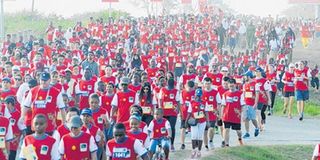Run for fun and eventually improve the world

The participants of the five and nine kilometres walk head on, on Toure-Drive. PHOTOSI COURTESY OF ROTARY CLUB.
What you need to know:
- While the first runners already turned left on the Toure-Drive, the runners in the back of the field cheer and applaud themselves again and just follow the frontline runners. They all run under the headline: “Heels to heal.“
“Ten, Nine, Eight, Seven, Six…” The crowd cheers and applauds for itself. In the frontline, the athletes lean slightly forward. “… Four, Three…” the first take a step forward. “…Two, one…”, the frontline-runners dash forward. They won’t wait for the final “go”, they just start the race. “…one, gooo!…”
While the first runners already turned left on the Toure-Drive, the runners in the back of the field cheer and applaud themselves again and just follow the frontline runners. They all run under the headline: “Heels to heal.“
Louisa, a young german trainee at GIZ, a German NGO in international cooperation, is amongst the participants. She got up at 5:00 am in Kinondoni, wore the red t-shirt of the event which she got earlier that week, running shoes and tight running pants. She ate a banana and drank some water and left her room at 5:15. Now, she is on the road. She participates, because GIZ funded all the participating employees the starting-fee of Sh 30,000. And she is amongst the runners, because she wants to fulfill her dream of running a half-marathon.
“This is something, I wanted to do a long time ago,” she says.
It is 6.15 am, the ocean to its right, the rising sun in the back and 21.1 Km to the finishing-line. Louisa and the many participants leave the starting area within seconds and take the left-turn to the Toure-Drive. While Louisa disappears with the crowd, the cyclists are preparing themselves to start 15 minutes later.
The reason, why the people got up so early in the morning of Nyerere Day, on October 14 is not only the heat of the day, but also the event itself. Organised by the Rotary Clubs of Dar es Salaam, the Rotary Dar Marathon has according to the organisers become the biggest sport-event in Dar es Salaam.
While the first groups left the Kenyatta-Green between the City-Centre of Dar es Salaam and the Oysterbay peninsula, more and more people with red t-shirts and blue or yellow numbers attached to it walk to the starting-point. All of them will take off at 7.00 am either to walk the nine or the five kilometres pleasure-walk along Coco Beach, Chole Road and Haile Selassie Road.
In the crowd, people from all over the world and from different organisations participate. There are students from the University of Dar es Salaam, from secondary-school, their parents and some grand-parents as well. The sun shines already warmly on the crowd, some are having a chat with their neighbours, others are just listening to the music and the speakers. Suddenly, the crowd moves forward. The walk has just begun.
While in the middle, the pace is very unhurried and comfortable, to the left and right people start to run faster and overtake their slower co-participants. After some 200 metres on Toure Drive, Coco Beach appears on the right side.
The street is a sea of red t-shirts-wearing walkers and runners, going along the famous beach. In the front rows, the more ambitious runners are taking the lead. In the back, children and less ambitious walkers are paving their way to the finishing-line.
As the city slowly awakes, the traffic starts to increase. On Chole Drive, after 45 minutes of walking and running, on the left the road trench, on the right the cars rhythmic chanting and stamping steps are coming closer. The group holds it pace continuously and goes further along Chole Road. They just enjoy the time together and the team-spirit of running and chanting together.
Another one on the road is Farsi. He is one of the very first followers of the event, yet he is not a Rotarian. He was amongst the 700 people participating in 2009 as the marathon was organised the first time. And he is now one of 13,000 runners, participating the 7th time.
“If training allows, I would like to run the half-marathon next year,” he says. This year, he went for the nine kilometres pleasure walk. “I enjoyed it very much,” he says after the race. He is mainly participating, because he likes to do sport with others. He likes challenges and the feeling of doing something good.
Not surprisingly, social media was almost flooded by selfies and posts with the Hashtags #Rotarydarmarathon, #Darmarathon #transformingliveswitheverystep.
Luke Benett shared a selfie together with his son. “Our first Dar rotary 21.1 cycle,” he wrote and seemed to be very elated. El-Medy van Khan posted a selfie of himself, after completing the run. And Rachel King wished all the participants a great run in the early morning of Nyerere Day.
On Twitter, a woman wrote: “Finished the #Darmarathon then slept for 4 hours,” while Brian Paul Mnyampi, who finished the half marathon in two hours and 28 minutes wrote: “As I crossed the line, I could feel the lack of oxygen filling my brain…”
And there is another thing: most of the participants who expressed themselves via social media share their happiness of being part of the race. Asif Karim and his friends shared a selfie of their success. Proudly they declare that they just finished the 9km-walk. They had a good time with their friends, families or just alone and enjoyed the morning at the beach.
While on Friday the Race was finished with some good vibes, another ultra-marathon is still going on. “We are doing a lot of homework before we take any decision on where and how to build the “Rotary Teaching Hospital,” Rotarian Nirmal explained earlier in the morning.
“It is still a long way to go. Currently we are conducting a feasibility-study to find out, where we want to spend the money exactly.” The marathon is just one part of the project, yet it seems to be the most involving.
Email: [email protected]




